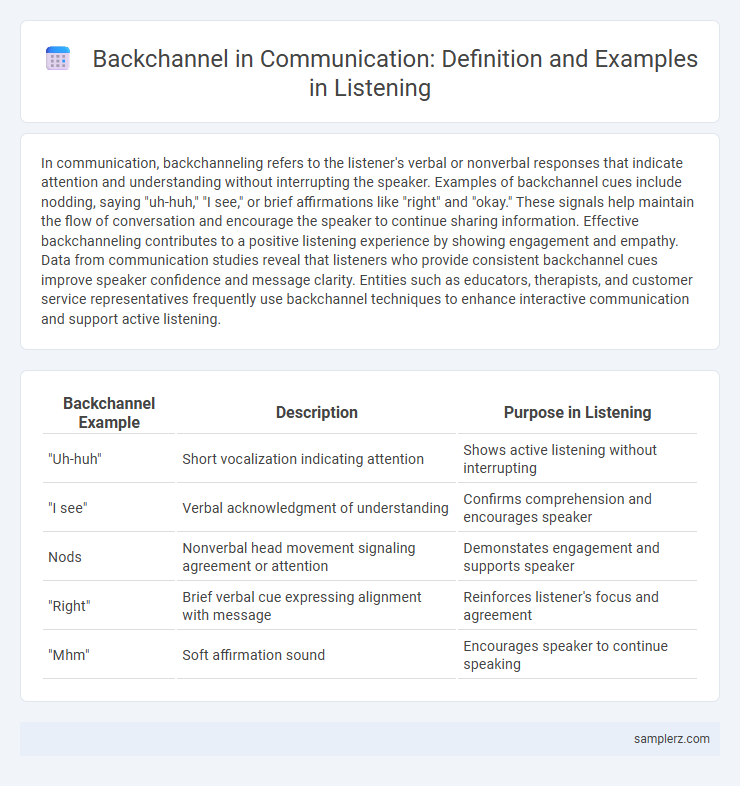In communication, backchanneling refers to the listener's verbal or nonverbal responses that indicate attention and understanding without interrupting the speaker. Examples of backchannel cues include nodding, saying "uh-huh," "I see," or brief affirmations like "right" and "okay." These signals help maintain the flow of conversation and encourage the speaker to continue sharing information. Effective backchanneling contributes to a positive listening experience by showing engagement and empathy. Data from communication studies reveal that listeners who provide consistent backchannel cues improve speaker confidence and message clarity. Entities such as educators, therapists, and customer service representatives frequently use backchannel techniques to enhance interactive communication and support active listening.
Table of Comparison
| Backchannel Example | Description | Purpose in Listening |
|---|---|---|
| "Uh-huh" | Short vocalization indicating attention | Shows active listening without interrupting |
| "I see" | Verbal acknowledgment of understanding | Confirms comprehension and encourages speaker |
| Nods | Nonverbal head movement signaling agreement or attention | Demonstates engagement and supports speaker |
| "Right" | Brief verbal cue expressing alignment with message | Reinforces listener's focus and agreement |
| "Mhm" | Soft affirmation sound | Encourages speaker to continue speaking |
Understanding Backchanneling in Communication
Backchanneling in communication includes verbal cues such as "uh-huh," "I see," or nodding signals that indicate active listening and understanding without interrupting the speaker. These brief responses function to provide feedback and encourage the speaker to continue, enhancing conversational flow and mutual comprehension. Effective backchanneling is integral to maintaining engagement and demonstrating empathy in interpersonal communication.
Importance of Backchannel Responses in Listening
Backchannel responses, such as nodding, "uh-huh," and brief verbal affirmations, play a crucial role in active listening by signaling attention and understanding to the speaker. These subtle cues encourage speakers to continue, enhance conversational flow, and reduce misunderstandings by providing immediate feedback. Effective backchanneling fosters collaboration and builds trust, making communication more interactive and engaging.
Common Verbal Backchannel Cues
Common verbal backchannel cues in communication include brief responses such as "uh-huh," "I see," and "right," which signal active listening without interrupting the speaker. These cues help maintain the flow of conversation and demonstrate understanding and engagement. Effective use of verbal backchannels enhances interpersonal connection and facilitates smoother dialogue.
Nonverbal Backchannel Signals in Conversation
Nonverbal backchannel signals in conversation include nodding, eye contact, and facial expressions that demonstrate active listening and encourage the speaker to continue. These subtle gestures provide feedback without interrupting the flow of communication, enhancing understanding and engagement. Effective use of nonverbal backchannels improves conversational dynamics by signaling attention and empathy.
Cultural Variations in Backchanneling
Backchanneling behaviors such as nodding, vocal affirmations, or brief verbal responses vary significantly across cultures, influencing listener-speaker dynamics. For example, Japanese listeners frequently use subtle vocal cues like "un" or "hai" to indicate attention without interrupting, whereas American listeners often employ more explicit verbal affirmations like "uh-huh" or "right." Understanding these cultural variations in backchanneling is crucial for effective cross-cultural communication and avoiding misinterpretations during conversations.
Backchanneling in Digital Communication
Backchanneling in digital communication includes real-time indicators such as typing notifications, read receipts, and emoji reactions, which signal active listening and engagement during conversations. These digital cues enhance interaction by providing immediate feedback without interrupting the speaker's flow. Effective use of backchanneling tools supports clearer understanding and stronger connections in virtual communication platforms.
Role of Backchanneling in Active Listening
Backchanneling in active listening includes verbal cues like "uh-huh," "I see," and nonverbal signals such as nodding, which encourage the speaker to continue and confirm understanding. These immediate feedback mechanisms enhance communication by demonstrating attentiveness and facilitating a dynamic exchange of information. Effective backchanneling reduces misunderstandings and strengthens the listener-speaker connection in conversations.
Examples of Backchanneling in Everyday Dialogue
Backchanneling in everyday dialogue includes short verbal cues such as "uh-huh," "I see," and "right," which signal active listening without interrupting the speaker. Nonverbal backchannels like nodding, eye contact, and facial expressions also play a crucial role in maintaining conversational flow and showing engagement. These subtle feedback mechanisms enhance communication by encouraging speakers to continue and clarifying listener comprehension.
Impact of Backchanneling on Speaker Engagement
Backchanneling, characterized by verbal cues such as "uh-huh," "I see," and non-verbal nods, plays a critical role in enhancing speaker engagement during communication. This responsive feedback signals active listening and understanding, encouraging speakers to elaborate and maintain conversational flow. Research indicates that effective backchanneling fosters trust and increases speaker confidence, ultimately improving the overall interactive communication experience.
Strategies for Effective Backchannel Usage
Effective backchannel strategies include using verbal cues such as "uh-huh," "I see," and brief affirmations to signal active listening and encourage the speaker without interrupting. Non-verbal signals like nodding, eye contact, and appropriate facial expressions enhance engagement and demonstrate comprehension. Balancing frequency and timing of backchannels prevents disruption and fosters a supportive communication environment.

example of backchannel in listening Infographic
 samplerz.com
samplerz.com